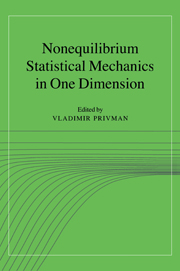Book contents
- Frontmatter
- Contents
- Contributors
- Preface
- Part I Reaction-Diffusion Systems and Models of Catalysis
- Part II Kinetic Ising Models
- Part III Ordering, Coagulation, Phase Separation
- 7 Phase-ordering dynamics in one dimension
- 8 Phase separation, cluster growth, and reaction kinetics in models with synchronous dynamics
- 9 Stochastic models of aggregation with injection
- Part IV Random Adsorption and Relaxation Processes
- Part V Fluctuations in Particle and Surface Systems
- Part VI Diffusion and Transport in One Dimension
- Part VII Experimental Results
- Index
- Abbreviations
7 - Phase-ordering dynamics in one dimension
Published online by Cambridge University Press: 18 December 2009
- Frontmatter
- Contents
- Contributors
- Preface
- Part I Reaction-Diffusion Systems and Models of Catalysis
- Part II Kinetic Ising Models
- Part III Ordering, Coagulation, Phase Separation
- 7 Phase-ordering dynamics in one dimension
- 8 Phase separation, cluster growth, and reaction kinetics in models with synchronous dynamics
- 9 Stochastic models of aggregation with injection
- Part IV Random Adsorption and Relaxation Processes
- Part V Fluctuations in Particle and Surface Systems
- Part VI Diffusion and Transport in One Dimension
- Part VII Experimental Results
- Index
- Abbreviations
Summary
Exact solutions for the phase-ordering dynamics of three one-dimensional models are reviewed in this chapter. These are the lattice Ising model with Glauber dynamics, a nonconserved scalar field governed by time-dependent Ginzburg-Landau (TDGL) dynamics, and a nonconserved 0(2) model (or XY model) with TDGL dynamics. The first two models satisfy conventional dynamic scaling. The scaling functions are derived, together with the (in general nontrivial) exponent describing the decay of autocorrelations. The 0(2) model has an unconventional scaling behavior associated with the existence of two characteristic length scales—the ‘phase coherence length’ and the ‘phase winding length’.
Introduction
The theory of phase-ordering dynamics, or ‘domain coarsening’, following a temperature quench from a homogeneous phase to a two-phase region has a history going back more than three decades to the pioneering work of Lifshitz, Lifshitz and Slyozov, and Wagner. The current status of the field has been recently reviewed.
The simplest scenario can be illustrated using the ferromagnetic Ising model. Consider a temperature quench, at time t = 0, from an initial temperature TI, which is above the critical temperature TC to a final temperature TF, which is below TC-At TF there are two equilibrium phases, with magnetization ±M0. Immediately after the quench, however, the system is in an unstable disordered state corresponding to equilibrium at temperature TI. The theory of phase-ordering kinetics is concerned with the dynamical evolution of the system from the initial disordered state to the final equilibrium state.
- Type
- Chapter
- Information
- Nonequilibrium Statistical Mechanics in One Dimension , pp. 143 - 166Publisher: Cambridge University PressPrint publication year: 1997

